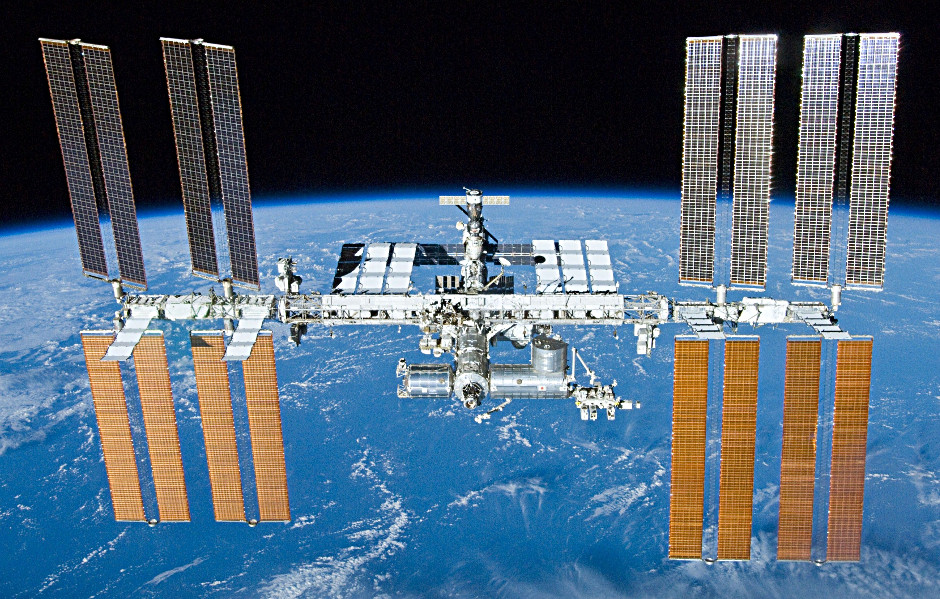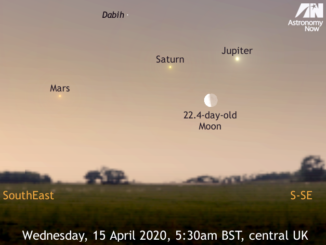
On this day fifty years ago, Apollo 11 blasted off from Kennedy Space Centre at 13:32 UTC on its historic eight-day journey to put men on the Moon and safely return them to Earth.
If you wish to indulge in a some lunar gazing to commemorate this momentous anniversary, clear UK skies around civil dusk permit you to see not only a partially eclipsed Moon low in the southeast with Saturn nearby, but brighter planetary sibling Jupiter in the south and, if you’re particularly fortunate, the International Space Station gliding by from 10:06–10:09pm BST!
While most celestial objects require a telescope or binocular to see clearly, the bright and unmistakable International Space Station makes regular visits to the night sky and may be enjoyed with nothing more than the naked eye, whether you live in the country or the heart of a light-polluted city. The ISS will be well seen from the British Isles over the next week, appearing like a slowly moving bright star crossing the sky in an arc from west to east, a few times each night from the UK.
About the ISS
Construction of the ISS began with the launch of the first module, Zarya, in November 1998. Since then, more than 115 constructional space flights using five different types of launch vehicles have led to the 73 x 109 x 20 metre, 400-tonne structure that we see today. The orbital outpost has completed more than 117,000 orbits since its launch and has been continuously occupied since November 2000.
Using Astronomy Now’s Almanac to make ISS viewing predictions
Many of you may have used our online Almanac to obtain information about lunar phases, or the rising and setting of the Sun, Moon and planets for wherever you may live, but the Almanac can also tell you when and where to see the International Space Station.
In the Almanac, select the closest city to your location from the Country and City pull-down menus before ensuring that the box beside Add ISS passes? has a tick in it and — just as importantly — the Daylight Savings Time? box, if applicable to your time and location. The table underneath the month’s Moon phase data then shows current nighttime passes of the International Space Station over your chosen location during the next five days, if any.
Here is a recent example computed for Cardiff: For the given Date in year/month/day format, Local Time is the instant the ISS first becomes visible and Duration indicates the length of the sighting in minutes. At the given Local Time, look in the direction indicated by Approach and, weather permitting, you should see the ISS as a slowly moving, bright “star”. Max. elevation is how high the Station will get above your horizon (90° is overhead, while 20° is about the span of an outstretched hand at arm’s length) and Departure indicates where the ISS will be when it vanishes from sight. Sometimes an appearance or disappearance occurs well up in the sky when the Station emerges into sunlight or slips into Earth’s shadow, respectively.
For the given Date in year/month/day format, Local Time is the instant the ISS first becomes visible and Duration indicates the length of the sighting in minutes. At the given Local Time, look in the direction indicated by Approach and, weather permitting, you should see the ISS as a slowly moving, bright “star”. Max. elevation is how high the Station will get above your horizon (90° is overhead, while 20° is about the span of an outstretched hand at arm’s length) and Departure indicates where the ISS will be when it vanishes from sight. Sometimes an appearance or disappearance occurs well up in the sky when the Station emerges into sunlight or slips into Earth’s shadow, respectively.
In the example above, as seen from the Welsh capital on the morning of Wednesday, 17 July, the ISS first appears 16° (a span and a half of a fist at arm’s length) above the western (W) horizon at 1:18am BST in a viewing window lasting six minutes. It attains a peak altitude of 69° above the east-northeast (ENE) horizon before fading into the Earth’s shadow 10° above the eastern (E) horizon at 1:24am BST.
Note: the actual times of events in the future will change as the orbit of the ISS varies over time; predictions made on the day are more accurate.
Viewing the ISS through a telescope?

In practice, trying to track the ISS with an undriven telescope such as a Dobsonian feels rather like clay pigeon shooting, as one attempts to anticipate where it will be in the finder before catching a glimpse as it flashes through the field a high-power eyepiece in a fraction of a second. However, practice makes perfect, and if a carefully focused astrovideo camera is used in place of an eyepiece, some frames on playback can contain tantalising images.
Observers with computerised telescope mounts that can be driven by external software designed to track satellites a have a much greater chance of success. Astrophotographers Thierry Legault and Ralf Vandebergh among many others have succeeded in capturing stunning pictures of the ISS showing fine structural detail that are an inspiration to imagers the world over.
Yet the serene beauty of the International Space Station gliding silently overhead needs nothing more than the naked eye to appreciate. Furthermore, if you do make a sighting over the next few nights, contemplate the six-person crew of Expedition 60 currently aboard – particularly on this epic anniversary of Apollo 11’s Moon mission.



